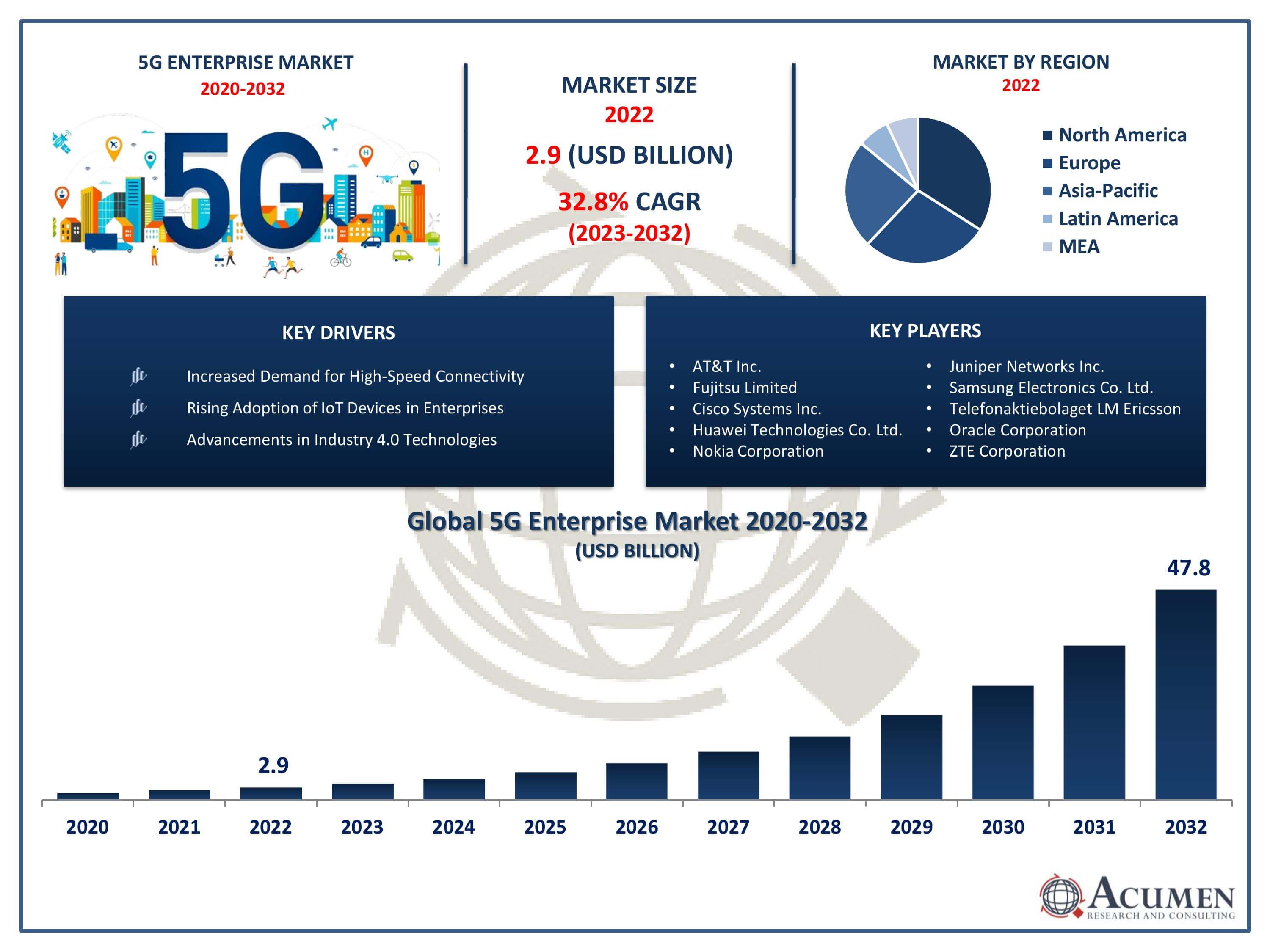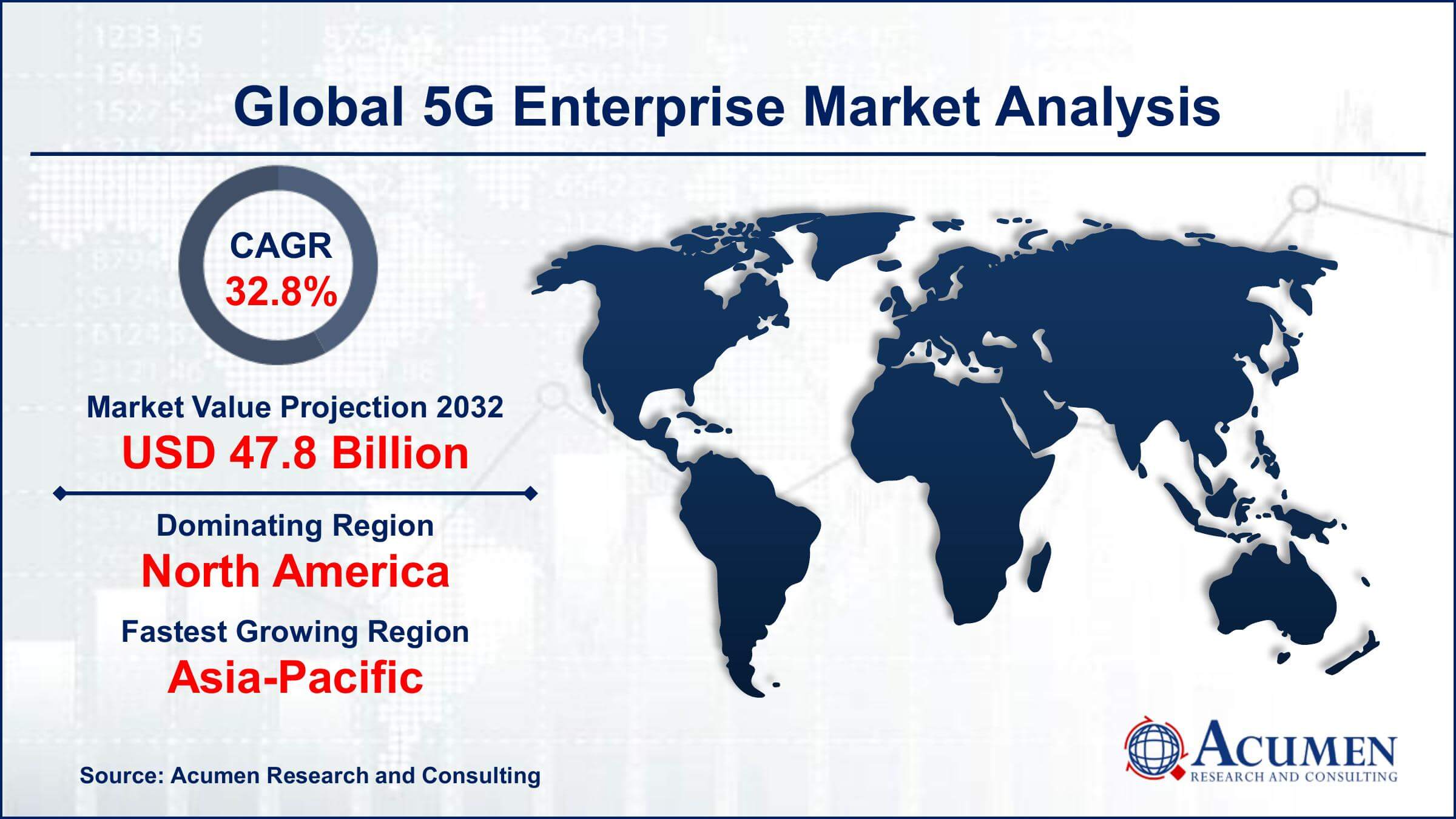May 2020
5G Enterprise Market Size accounted for USD 2.9 Billion in 2022 and is projected to achieve a market size of USD 47.8 Billion by 2032 growing at a CAGR of 32.8% from 2023 to 2032.
The 5G Enterprise Market Size accounted for USD 2.9 Billion in 2022 and is projected to achieve a market size of USD 47.8 Billion by 2032 growing at a CAGR of 32.8% from 2023 to 2032.
5G Enterprise Market Highlights

5G enterprise refers to the use of 5G technology in various industries and businesses to enhance connectivity, communication, and operational efficiency. Unlike previous generations of mobile networks, 5G offers significantly higher data speeds, lower latency, and increased device connectivity. These features enable enterprises to deploy advanced applications such as the Internet of Things (IoT), augmented reality (AR), virtual reality (VR), and artificial intelligence (AI) in real-time, transforming the way businesses operate. With 5G, enterprises can create smart factories, implement remote healthcare services, enable autonomous vehicles, and optimize supply chain management, among other applications.
The market for 5G enterprise solutions has been experiencing rapid growth in recent years and is expected to continue expanding in the coming years. As more businesses recognize the transformative potential of 5G technology, there is a growing demand for 5G-enabled devices, infrastructure, and services. Industries such as manufacturing, healthcare, transportation, energy, and entertainment are embracing 5G to enhance their operations and services. Additionally, the COVID-19 pandemic has accelerated the adoption of remote working and digital solutions, further fueling the demand for robust and high-speed connectivity provided by 5G networks. With ongoing investments in 5G infrastructure by telecommunications companies and advancements in 5G-compatible devices, the enterprise 5G market is poised for significant growth, creating new opportunities for businesses and driving economic development globally.
Global 5G Enterprise Market Trends
Market Drivers
Market Restraints
Market Opportunities
5G Enterprise Market Report Coverage
| Market | 5G Enterprise Market |
| 5G Enterprise Market Size 2022 | USD 2.9 Billion |
| 5G Enterprise Market Forecast 2032 | USD 47.8 Billion |
| 5G Enterprise Market CAGR During 2023 - 2032 | 32.8% |
| 5G Enterprise Market Analysis Period | 2020 - 2032 |
| Base Year |
2022 |
| Forecast Data | 2023 - 2032 |
| Segments Covered | By Frequency, By Spectrum, By Network Type, By Industry Vertical, And By Geography |
| Regional Scope | North America, Europe, Asia Pacific, Latin America, and Middle East & Africa |
| Key Companies Profiled | AT&T Inc., Fujitsu Limited, Cisco Systems Inc., Huawei Technologies Co. Ltd., Hewlett Packard Enterprise Company, Nokia Corporation, Juniper Networks Inc., Samsung Electronics Co. Ltd., Telefonaktiebolaget LM Ericsson, Oracle Corporation, ZTE Corporation, and Verizon Communications Inc. |
| Report Coverage |
Market Trends, Drivers, Restraints, Competitive Analysis, Player Profiling, Covid-19 Analysis, Regulation Analysis |
With 5G, businesses can establish highly reliable and low-latency connections, paving the way for innovations in sectors such as manufacturing, healthcare, transportation, and logistics. One of the key applications of 5G in the enterprise sector is the Internet of Things (IoT). 5G networks can support a vast number of IoT devices, allowing businesses to collect and process data from sensors, machinery, and other connected devices in real-time. This real-time data analysis is invaluable for industries like manufacturing, where it enables predictive maintenance, process optimization, and efficient inventory management. Additionally, 5G facilitates the implementation of augmented reality (AR) and virtual reality (VR) technologies in various fields. In healthcare, for instance, 5G-powered AR can be used for remote consultations and surgeries, providing doctors with detailed, real-time information.
The 5G enterprise market is experiencing remarkable growth as businesses across various industries recognize the transformative potential of this technology. With its unparalleled speed, low latency, and capacity to handle a massive number of connected devices simultaneously, 5G is driving innovation and efficiency in enterprise operations. Industries such as manufacturing, healthcare, transportation, and logistics are leveraging 5G to enhance automation, enable real-time monitoring, and improve overall productivity. Furthermore, the expanding 5G chipset market and 5G services market are driving the enterprise 5G market even further.The integration of 5G networks allows for seamless communication between machines, enabling businesses to optimize their supply chains, monitor equipment remotely, and enhance decision-making processes. Moreover, the COVID-19 pandemic has accelerated the adoption of remote work solutions, leading to a surge in demand for robust and reliable 5G networks to support virtual collaboration and communication tools. This increased need for high-speed, low-latency connectivity has further fueled the growth of the enterprise 5G market.
5G Enterprise Market Segmentation
The global 5G Enterprise Market segmentation is based on frequency, spectrum, network type, industry vertical, and geography.
5G Enterprise Market By Frequency
According to the 5G enterprise industry analysis, the mmWave segment accounted for the largest market share in 2022. MmWave technology operates on a higher frequency band, enabling it to transmit vast amounts of data at remarkable speeds, making it ideal for bandwidth-intensive applications in enterprise environments. One of the key drivers of the mmWave segment's growth is its capacity to support high-data applications such as augmented reality (AR), virtual reality (VR), and high-definition video conferencing. These applications demand rapid data transfer and low latency to function seamlessly, making mmWave technology indispensable for businesses aiming to enhance communication and collaboration experiences. Moreover, the mmWave segment is crucial for enabling the deployment of private 5G networks within enterprises.
5G Enterprise Market By Spectrum
In terms of spectrums, the licensed segment is expected to witness significant growth in the coming years. Licensed spectrum bands are allocated by regulatory authorities, ensuring that businesses operate on designated frequencies without interference. This predictability and stability in the licensed segment make it particularly attractive for enterprises seeking robust and secure 5G connectivity. Industries such as manufacturing, healthcare, and logistics, where mission-critical applications require uninterrupted communication, are increasingly turning to licensed spectrum solutions. These businesses rely on licensed spectrum to support applications like real-time monitoring, automation, and precise control systems, where any signal disruption can have significant consequences. Furthermore, licensed spectrum offers enhanced security features, making it ideal for businesses dealing with sensitive data and confidential information.
5G Enterprise Market By Network Type
According to the 5G enterprise market forecast, the hybrid networks segment is expected to witness significant growth in the coming years. This segment grows as businesses increasingly recognize the benefits of combining various networking technologies to meet their diverse connectivity needs. Hybrid networks integrate 5G technology with existing infrastructures, including Wi-Fi, fiber optics, and even older cellular technologies. This integration allows for seamless connectivity, enabling enterprises to optimize their network performance, enhance reliability, and reduce operational costs. One of the key drivers of the hybrid networks segment's growth is its ability to offer flexibility. Businesses can leverage 5G for high-speed, low-latency applications while relying on Wi-Fi or other technologies for less bandwidth-intensive tasks. This flexibility ensures efficient resource utilization, enabling enterprises to adapt their networks based on the specific requirements of different applications and devices.
5G Enterprise Market By Industry Vertical
Based on the industry vertical, the IT and telecom segment is expected to continue its growth trajectory in the coming years. This growth is fueled by the increasing demand for high-speed, low-latency connectivity solutions. Enterprises within the IT and telecom sector are early adopters of 5G technology due to their intrinsic reliance on robust and efficient communication networks. Telecom companies are investing heavily in 5G infrastructure to provide enhanced services to their customers, including faster internet speeds, seamless video conferencing, and improved network reliability. Moreover, 5G enables telecom operators to expand their offerings to include services tailored for enterprise clients, such as private 5G networks, IoT solutions, and edge computing capabilities. These services empower businesses to enhance their operations, optimize network efficiency, and explore innovative applications in areas like smart cities and autonomous vehicles.
5G Enterprise Market Regional Outlook
North America
Europe
Asia-Pacific
Latin America
The Middle East & Africa

5G Enterprise Market Regional Analysis
North America is emerging as a dominant force in the global 5G enterprise market, largely due to robust infrastructure development, early adoption of advanced technologies, and significant investments by both the public and private sectors. The region has seen substantial efforts in rolling out 5G networks, with major telecom operators heavily investing in upgrading their infrastructure to support the burgeoning demands of businesses. With the United States at the forefront, North American countries have swiftly deployed 5G networks across urban centers and are now expanding coverage to suburban and rural areas. This extensive network coverage provides a strong foundation for enterprises to adopt 5G technologies for various applications, ranging from industrial automation and IoT to augmented reality and telemedicine. Moreover, North America boasts a vibrant ecosystem of technology companies, startups, and research institutions focused on 5G innovation. Silicon Valley, in particular, serves as a global hub for technological advancements, fostering collaborations between telecom giants and innovative startups. This synergy has led to the development of cutting-edge solutions and applications that leverage 5G capabilities, driving the region's dominance in the market. Additionally, regulatory support and initiatives from governments in North America have facilitated the rapid deployment of 5G infrastructure.
5G Enterprise Market Player
Some of the top 5G enterprise market companies offered in the professional report include AT&T Inc., Fujitsu Limited, Cisco Systems Inc., Huawei Technologies Co. Ltd., Hewlett Packard Enterprise Company, Nokia Corporation, Juniper Networks Inc., Samsung Electronics Co. Ltd., Telefonaktiebolaget LM Ericsson, Oracle Corporation, ZTE Corporation, and Verizon Communications Inc.
Looking for discounts, bulk pricing, or custom solutions? Contact us today at sales@acumenresearchandconsulting.com
May 2020
August 2023
February 2020
August 2017